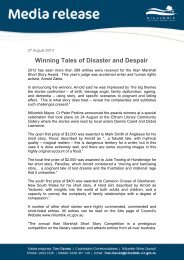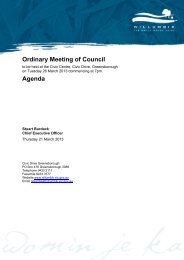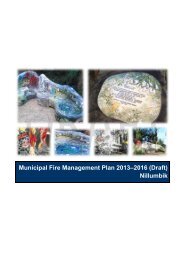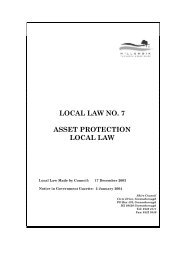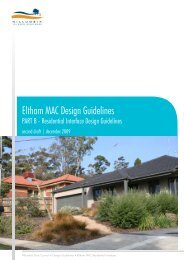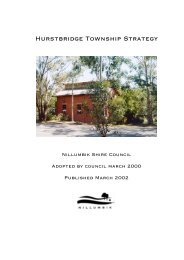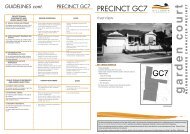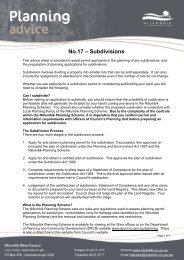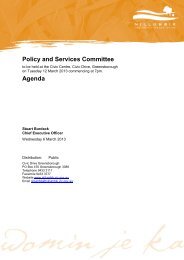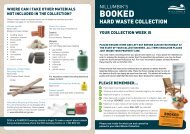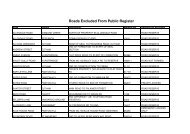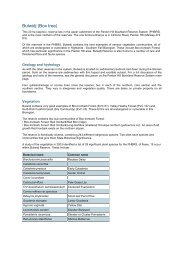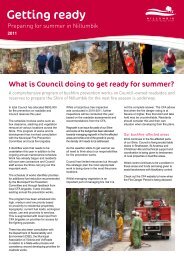Sustainable Water Management Plan - Nillumbik Shire Council
Sustainable Water Management Plan - Nillumbik Shire Council
Sustainable Water Management Plan - Nillumbik Shire Council
You also want an ePaper? Increase the reach of your titles
YUMPU automatically turns print PDFs into web optimized ePapers that Google loves.
Local Law relating to dog excrement<br />
Amenity Local Law Number 5 requires people<br />
in charge of dogs in public places to collect and<br />
appropriately dispose of any excrement deposited<br />
by that dog (Part 5 – Animals Clause 24). Signage<br />
and rubbish bags have been installed at several<br />
reserves to assist dog owners to comply. <strong>Council</strong><br />
staff also undertake several bike patrols each year<br />
throughout reserves to enforce this Law, however<br />
current resource levels limit the ability to undertake<br />
regular patrols.<br />
Environmental Events program<br />
<strong>Council</strong> runs a number of environmental events,<br />
seminars and workshops as part of its annual<br />
Environmental Events program. Events focus on<br />
providing sound environmental and sustainability<br />
education and ideas to local residents for<br />
implementation at home. Examples include<br />
designing an indigenous garden, sustainable and<br />
water efficient gardening, home composting and<br />
erosion prevention and control. Events are evaluated<br />
by participants which assists with the review and<br />
future development of the program to ensure<br />
community needs are met in future years.<br />
Wastewater management<br />
Domestic wastewater management<br />
<strong>Council</strong> developed and adopted the <strong>Nillumbik</strong><br />
Domestic Wastewater <strong>Management</strong> <strong>Plan</strong> in 2003<br />
to provide strategic direction in managing domestic<br />
wastewater issues in the <strong>Shire</strong>. Since its adoption,<br />
a number of actions from this <strong>Plan</strong> have been<br />
implemented.<br />
An effective permit and inspection program has been<br />
developed to ensure that all new or altered systems<br />
are installed as per the EPA Code of Practice for<br />
Septic Systems and include detailed conditions<br />
of use. Information collection and retention about<br />
systems within the <strong>Shire</strong> has improved, however<br />
some information is unavailable or often only<br />
accessible in individual property files. Opportunities<br />
for reporting on the number and status of systems<br />
and system performance with the current database<br />
are also limited. Effective education programs and<br />
surveys have assisted <strong>Council</strong> in assessing the<br />
problem and addressing issues but needs to be<br />
explored further.<br />
Greywater reuse options<br />
<strong>Council</strong> developed an information brochure on reuse<br />
options for greywater for the home, providing a<br />
brief overview of greywater treatment and diversion<br />
systems and the EPA regulations governing its use.<br />
Other<br />
Melbourne <strong>Water</strong>Watch support<br />
Melbourne <strong>Water</strong>watch is a community education<br />
program that involves volunteers from schools<br />
and community groups monitoring the health of<br />
our waterways. In <strong>Nillumbik</strong>, there are numerous<br />
<strong>Water</strong>watch groups monitoring sites along the<br />
Diamond Creek, Arthurs Creek, Watsons Creek and<br />
Yarra River. <strong>Council</strong> currently supports these groups<br />
through the provision of sampling equipment and<br />
materials in addition to jointly funding a Regional<br />
<strong>Water</strong>watch Coordinator with Banyule, Whittlesea,<br />
Yarra and Darebin City <strong>Council</strong>s.<br />
<strong>Sustainable</strong> Gardening Australia (SGA)<br />
SGA provides advice on gardening practices<br />
and clearly identifies low environmental impact<br />
products. SGA’s mission is to change the way all<br />
Australian garden to ensure that they are working<br />
with our environment when gardening. <strong>Council</strong> has<br />
supported SGA through the nursery accreditation<br />
program and industry and community training.<br />
APPENDIX G<br />
Best practice water management<br />
Best practice means undertaking operations that deliver the best environmental, social and financial<br />
outcomes for the organisation. 12 Through the development and implementation of this <strong>Plan</strong>, <strong>Council</strong><br />
has taken a significant step towards best practice water conservation in all of its operations.<br />
Key steps to achieving best practice in water conservation include:<br />
1. Understanding water demand<br />
Understanding water consumption levels, what<br />
the water is being used for, and who the user<br />
is, allows <strong>Council</strong> to strategically determine<br />
priority sites for water efficiency measures.<br />
2. Identifying water saving opportunities<br />
Identify the best water saving opportunities<br />
and implement actions that deliver big<br />
wins first.<br />
3. Implementing efficiency before reuse/<br />
recycling measures<br />
<strong>Council</strong>s are familiar with the 3Rs – reduce,<br />
reuse, recycle, and this should also be applied<br />
to water use. The installation of water efficient<br />
devices such as flow control valves and AAA<br />
rated white goods and showerheads are a<br />
low cost solution that deliver significant water<br />
savings. These devices are usually cheaper<br />
and easier to install than recycling/reuse<br />
methods and deliver shorter paybacks<br />
on investment.<br />
4. Creating partnerships<br />
By developing partnerships with key<br />
stakeholders in water conservation, <strong>Nillumbik</strong><br />
<strong>Shire</strong> <strong>Council</strong> can access expert advice, share<br />
costs in projects and remain at the forefront on<br />
water conservation issues. Key stakeholders<br />
include Yarra Valley <strong>Water</strong>, Melbourne <strong>Water</strong>,<br />
ICLEI, all levels of government and the<br />
community.<br />
5. Monitor and evaluate actions<br />
Monitoring and evaluation is the key to<br />
ensuring that investments remain strategic<br />
and assist in determining whether actions<br />
are delivering the best outcomes. Monitoring<br />
results also helps to identify real outcomes in:<br />
• Environment – volume of water saved<br />
and not removed from rivers and storage<br />
facilities, reduction in energy and chemicals<br />
used to treat and transport the water before<br />
it gets to the tap.<br />
• Social – behaviour change, enhanced<br />
awareness, community and stakeholder<br />
partnerships.<br />
• Financial – cost savings from reduced<br />
water use and waste water disposal<br />
charges, e.g. Sewage Disposal Charge,<br />
Trade Waste charges<br />
12<br />
www.clearwater.asn.au<br />
What is best practice in water conservation?<br />
60 <strong>Sustainable</strong> <strong>Water</strong> <strong>Management</strong> <strong>Plan</strong> <strong>Sustainable</strong> <strong>Water</strong> <strong>Management</strong> <strong>Plan</strong>



